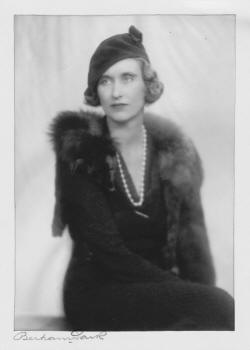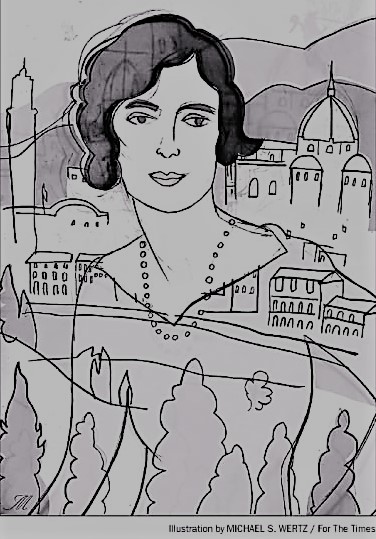

Queer Places:
La Foce, Strada della Vittoria, 61 Chianciano Terme, 53042 Chianciano Terme SI
Palazzo Orsini, now Palazzo Pio Righetti,
Via del Biscione, 1, 00186 Roma RM
Gli Scafari, Via Fiascherino, 2, 19032 Tellaro SP
Cimitero Degli Origo
Chianciano Terme, Provincia di Siena, Toscana, Italy
 Dame Iris Margaret Origo, Marchesa Origo, DBE (née Cutting; 15 August 1902 – 28 June 1988) was an English-born biographer and writer. She lived in Italy and devoted much of her life to improving the Tuscan estate at La Foce, near Montepulciano, which she bought with her husband in the 1920s. During the Second World War, she persistently sheltered refugee children and helped many escaped Allied prisoners of war and partisans, in defiance of Italy's fascist regime and Nazi occupation forces.
Dame Iris Margaret Origo, Marchesa Origo, DBE (née Cutting; 15 August 1902 – 28 June 1988) was an English-born biographer and writer. She lived in Italy and devoted much of her life to improving the Tuscan estate at La Foce, near Montepulciano, which she bought with her husband in the 1920s. During the Second World War, she persistently sheltered refugee children and helped many escaped Allied prisoners of war and partisans, in defiance of Italy's fascist regime and Nazi occupation forces.
Origo was born at Beechwood Cottage, Birdlip, Gloucestershire, England,[1] to the diplomat William Bayard Cutting Jr. and Lady Sybil Marjorie Cuffe (daughter of Lord Desart, an Irish peer). The Cutting family was a known wealthy and philanthropic New York family (Origo was a granddaughter of William Bayard Cutting). Her parents travelled widely after their marriage, particularly in Italy, where her father contracted tuberculosis. He then travelled the world in search of relief from the symptoms of the disease, which would kill him in 1910 at the age of 29. Before he died, William wrote to his wife that he wanted their young daughter to grow up in Italy, "free from all this national feeling which makes people so unhappy. Bring her up somewhere where she does not belong, so she cannot have it."[2][3] Iris and her mother settled in Italy, buying Villa Medici in Fiesole, one of Florence's most spectacular villas. There they became close friends with Bernard Berenson, who lived at nearby I Tatti. Iris was briefly enrolled at a London school, but mainly taught at home, by Professor Solone Monti and a series of French and German governesses.[4] In April 1918 her mother remarried, to the architectural historian Geoffrey Scott, also of the Berensonian circle. She divorced him in 1926 and took a third husband, the essayist Percy Lubbock.[1][5]
Iris Cutting travelled to England and the United States, so as to be launched into society in both countries. In 1922, she met Colin Mackenzie, a young Scottish businessman working in Milan; a romantic correspondence was followed by a passionate affair.[5] On 4 March 1924, Iris married Antonio Origo, an illegitimate son of Marchese Clemente Origo. They moved to their purchased 7,000 acres (2,800 ha) estate, La Foce, near Chianciano Terme in the Province of Siena. It was in an advanced state of disrepair, but their hard work, care and attention managed to transform it. Their son, Gian or Gianni Clemente Bayard (24 June 1925 – 30 April 1933), died of meningitis at the age of seven. They also had two daughters, Benedetta (born 1 August 1940) and Donata (born 9 June 1943).

After the death of her son, Iris Origo began a writing career with a well-received biography of Giacomo Leopardi, published in 1935. A reviewer noted that "an unobtrusive scholarship gives alimentation to a deft power in narrative, and the style is always alive and sometimes very beautiful."[6] She followed this in 1938 with a life of Cola di Rienzo, a 14th-century populist revolutionary and would-be dictator in Rome. After discovering love letters between George Gordon Byron and the Countess Teresa Guiccioli she wrote "The Last Attachment" about their relationship. "The Merchant of Prato" is about everyday 14th-century life, a book Origo wrote after examining a huge cache of medieval documents.[7][3] The Origos spent the Second World War at La Foce caring for refugee children, and after Italy (but not Germany) surrendered, helping escaped Allied prisoners of war trying to cross German lines or simply survive. After the war, she divided her time between La Foce and Rome, where the Origos had bought an apartment in the Palazzo Orsini, and devoted herself to writing. War in Val d'Orcia (1947) was her first book to be popular as well as a critical success.[5][8] Her 1957 book The Merchant of Prato was found to be a valuable source for students of Italian city and mercantile life, based on research in the archives of the merchant Francesco di Marco Datini (1335–1410). She also cast light on a little-known facet of medieval and early Italian life in an article, "The Domestic Enemy: the Eastern Slaves in Tuscany in the Fourteenth and Fifteenth Centuries".[9] The Origos holidayed at Gli Scafari, a house built by the architect Cecil Ross Pinsent for Iris's mother, at Lerici on the Gulf of Spezia.[10] Antonio Origo died on 27 June 1976. Iris Origo died at her estate in Tuscany on 28 June 1988, aged 85.[11]
Iris Origo was elected a Fellow of the American Academy of Arts and Sciences in 1967.[12] On 31 December 1976 she was appointed Dame Commander of the Order of the British Empire (DBE) "for services to British cultural interests in Italy and to Anglo-Italian relations".[1] La Foce is the birthplace of a chamber music festival held in Iris Origo's memory, organised by her grandson, the cellist Antonio Lysy.[13][14][15]
My published books: